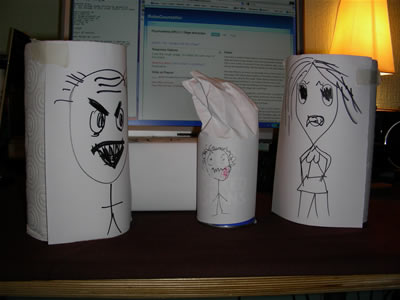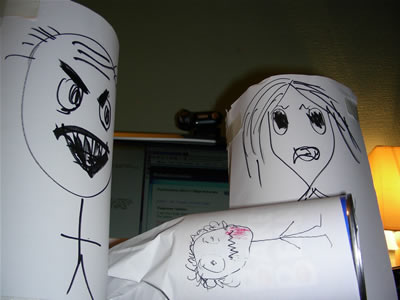
Psycho (Tabletop Psychodrama): Home
AUDIO: (shown in blue below) Note: For an identical copy of this page but with the audio muted, click here.Reminder re audio: This module works FAR better when downloaded to your own computer than online. There will be severe latency issues (delays) with Psycho because the audio files are literally 10x the size of most other audio files at PaulsRobot3.
Response Options:• Great! Let's get on with the instructionsMini screenplayINTERNAL. PARENTS' BEDROOM AT HOME - NIGHT CHILD (client) lies on floor, looking up at FATHER looming over her. She is crying. CHILD FATHER Father SMACKS child with hand. Child CRIES OUT. MOTHER BackgroundJacob L. Moreno developed psychodrama in the 1930s and 40s. There is a stage, often simply a table and chairs. There is a director/therapist and a hero and villain, with a supporting cast and an audience. The client would usually play the part of the hero, the drama being some issue in her past, present or future life she wishes to work on. Other people play the other roles.In this way, hidden thoughts and feelings are brought to the surface and often expressed, and catharsis — a release of feeling — can occur. Later analysis can help bring about a change in thinking and feeling about the issue explored. AlterationsThis can be very effective. But one big problem with having other people play the supporting roles is that they tend to inject things into the scene that do not fit with the client's view of what took place or should have taken place. Similarly, the therapist's evaluations can be off the mark.ProtestThe resulting protest in the client (often unvoiced) can overshadow the therapeutic value of the re-enactment. |
Setting the stage This module is based on traditional psychodrama, but modified for PaulsRobot use. The client sits at a table, or suitable flat surface, with the computer and with various small objects like tissue boxes and tin cans. At PaulsRobot direction, the client writes out an outline in any format of this particular scene, then draws a represention of herself in that scene on paper, which she then wraps around a can, say. Then she positions her character front and centre on the stage, facing in to the action, not out to an audience. Then she creates the other characters and places them in their correct relative positions on the stage.
This module is based on traditional psychodrama, but modified for PaulsRobot use. The client sits at a table, or suitable flat surface, with the computer and with various small objects like tissue boxes and tin cans. At PaulsRobot direction, the client writes out an outline in any format of this particular scene, then draws a represention of herself in that scene on paper, which she then wraps around a can, say. Then she positions her character front and centre on the stage, facing in to the action, not out to an audience. Then she creates the other characters and places them in their correct relative positions on the stage.
Facing in to the action?In the two example photographs, the client is the child. She is shown as facing the camera for illustration only, so that you can see this character is the child. In a real session, she would be facing the opposite direction, into the action.Action! When directed, she runs through the scene. She starts by inhabiting her own character on the stage, usually with her head positioned directly above it, voicing each part herself, moving the characters around on the stage as appropriate, breathing life into the whole scene. She can whisper lovingly or yell and swear; nurture or ignore or even destroy a character as she chooses.
When directed, she runs through the scene. She starts by inhabiting her own character on the stage, usually with her head positioned directly above it, voicing each part herself, moving the characters around on the stage as appropriate, breathing life into the whole scene. She can whisper lovingly or yell and swear; nurture or ignore or even destroy a character as she chooses.
PaulsRobot will then direct her to write a summary of anything new, any change of viewpoint or feeling she has about the issue. She will then play through the action, one scene or many, again and again until the topic is no longer an issue. EffectivenessIf done with care, this Tabletop Psychodrama can be very effective at releasing one's emotional charge on a topic as the re-enactment preserves one's own view of things and does not inject unreality into the scene.17 possible variationsOne can choose from seventeen variations, including focusing on:
|